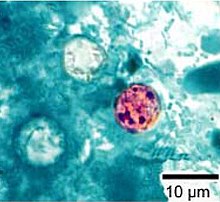The examples and perspective in this article deal primarily with the United States and do not represent a worldwide view of the subject. (September 2018) |
| Cyclospora cayetanensis | |
|---|---|

| |
| Cyclospora cayetanensis oocysts | |
| Scientific classification | |
| Domain: | Eukaryota |
| Clade: | Diaphoretickes |
| Clade: | SAR |
| Clade: | Alveolata |
| Phylum: | Apicomplexa |
| Class: | Conoidasida |
| Order: | Eucoccidiorida |
| Family: | Eimeriidae |
| Genus: | Cyclospora |
| Species: | C. cayetanensis
|
| Binomial name | |
| Cyclospora cayetanensis Ortega, Gilman & Sterling, 1994
| |
Cyclospora cayetanensis is a coccidian parasite that causes a diarrheal disease called cyclosporiasis in humans and possibly in other primates. Originally reported as a novel pathogen of probable coccidian nature in the 1980s[1] and described in the early 1990s,[1] it was virtually unknown in developed countries until awareness increased due to several outbreaks linked with fecally contaminated imported produce. C. cayetanensis has since emerged as an endemic cause of diarrheal disease in tropical countries and a cause of traveler's diarrhea and food-borne infections in developed nations.[1] This species was placed in the genus Cyclospora because of the spherical shape of its sporocysts. The specific name refers to the Cayetano Heredia University in Lima, Peru, where early epidemiological and taxonomic work was done.[2]
- ^ a b c Ortega, Ynés R; Sanchez, Roxana (2010), "Update on Cyclospora cayetanensis, a food-borne and waterborne parasite", Clin Microbiol Rev, 23 (1): 218–234, doi:10.1128/CMR.00026-09, PMC 2806662, PMID 20065331.
- ^ "Cyclospora cayetanensis". Division of Biology, Kansas State University. Retrieved 31 October 2001.